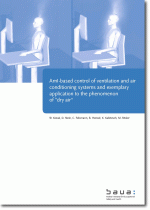AmI-based control of ventilation and air conditioning systems and exemplary application to the phenomenon of "dry air"
This interim report covers all activities of the research project: Chances and limitations of AmI-based control of ventilation and air conditioning systems and exemplary application to the phenomenon of "dry air". At first, an analysis of the kind of the contributions necessary to achieve a representative picture of the research topic at hand had been carried out. For this purpose, the measurable properties of the skin have been discussed and the state of the art of AmI (Ambient Intelligence) specified. The control of HVAC systems and visions of AmI control have also been thoroughly analyzed.
In addition to the requirements of an AmI-based humidity control the report specifically focuses on measurements of evaporation from the skin, that have been conducted on the specially designed test specimen in a dedicated test facility. These experiments were necessary because the data found during the comprehensive literature review did not account for the variation of the room air parameters. The measurements produced the matrix of the evaporation rates as a function of the local climatic conditions.
Furthermore, a building simulation program has been extended to take the human skin evaporation into account and used to carry out the needed calculations. Preliminary results have shown the indoor air quality and humidity calculated with the single node model. In the next stage this simplified model has been coupled with a detailed field model for flow simulation in order to account the air flow influence. The resulting virtual office has combined detailed air flow analysis with the thermal and hygrical simulation and the results of the evaporation experiments. This set up been able to show that the flow in the room significantly affects the evaporation from the skin. The high expense of such calculations, however, significantly limits the number of calculations that can be carried out for the purpose of this study. The presented results offer valuable insights into the relationships between the heating and ventilation system and local climate in the vicinity of persons and provide important stimuli for the further development of AmI for HAVC systems but cannot and do not claim to represent the complete picture of the researched topic.
Bibliographic information
Title: AmI-based control of ventilation and air conditioning systems and exemplary application to the phenomenon of "dry air".
1. edition. Dortmund: Bundesanstalt für Arbeitsschutz und Arbeitsmedizin, 2015. pages: 20, Project number: F 2299, PDF file
